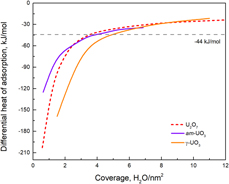Crossref Citations
This article has been cited by the following publications. This list is generated based on data provided by
Crossref.
Wang, Jun
Yılmaz, Esra
Zhang, Xianghui
Li, Houqian
Zhang, Renqin
Guo, Xiaofeng
Sun, Hui
Wang, Baodong
and
Wu, Di
2020.
Hydration Energetics of a Diamine-Appended Metal–Organic Framework Carbon Capture Sorbent.
The Journal of Physical Chemistry C,
Vol. 124,
Issue. 1,
p.
398.
Peruski, Kathryn M.
and
Powell, Brian A.
2020.
Effect of calcination temperature on neptunium dioxide microstructure and dissolution.
Environmental Science: Nano,
Vol. 7,
Issue. 12,
p.
3869.
Pastoor, Kevin J.
Robinson, Shane L.
Greenwell, R. Allan
Quintero Hilsaca, Camila V.
Shafer, Jenifer C.
and
Jensen, Mark P.
2020.
Understanding uranium oxide hardening during prolonged storage.
Radiochimica Acta,
Vol. 108,
Issue. 12,
p.
943.
Shelyug, Anna
and
Navrotsky, Alexandra
2021.
Thermodynamics of Fluorite-Structured Oxides Relevant to Nuclear Energy: A Review.
ACS Earth and Space Chemistry,
Vol. 5,
Issue. 3,
p.
703.
Marcial, J.
Zhang, Y.
Zhao, X.
Xu, H.
Mesbah, A.
Nienhuis, E. T.
Szenknect, S.
Neuefeind, J. C.
Lin, J.
Qi, L.
Migdisov, A. A.
Ewing, R. C.
Dacheux, N.
McCloy, J. S.
and
Guo, X.
2021.
Thermodynamic non-ideality and disorder heterogeneity in actinide silicate solid solutions.
npj Materials Degradation,
Vol. 5,
Issue. 1,
Pastoor, Kevin J.
Kemp, R. Scott
Jensen, Mark P.
and
Shafer, Jenifer C.
2021.
Progress in Uranium Chemistry: Driving Advances in Front-End Nuclear Fuel Cycle Forensics.
Inorganic Chemistry,
Vol. 60,
Issue. 12,
p.
8347.
Hanson, Alexa B.
Schwerdt, Ian J.
Nizinski, Cody A.
Lee, Rachel Nicholls
Mecham, Nicholas J.
Abbott, Erik C.
Heffernan, Sean
Olsen, Adam
Klosterman, Michael R.
Martinson, Sean
Brenkmann, Alexandria
and
McDonald, Luther W.
2021.
Impact of Controlled Storage Conditions on the Hydrolysis and Surface Morphology of Amorphous-UO3.
ACS Omega,
Vol. 6,
Issue. 12,
p.
8605.
Koishi, Ayumi
Lee, Sang Soo
Fenter, Paul
Fernandez-Martinez, Alejandro
and
Bourg, Ian C.
2022.
Water Adsorption on Mica Surfaces with Hydrophilicity Tuned by Counterion Types (Na, K, and Cs) and Structural Fluorination.
The Journal of Physical Chemistry C,
Vol. 126,
Issue. 38,
p.
16447.
Plakhova, Tatiana V.
Romanchuk, Anna Yu.
Konyukhova, Anastasia D.
Seregina, Irina F.
Baranchikov, Alexander E.
Svetogorov, Roman D.
Terban, Maxwell W.
Ivanov, Vladimir K.
and
Kalmykov, Stepan N.
2024.
Overlooked impact of surface hydroxylation on the solubility of less-soluble compounds: a case study of CeO2.
Environmental Science: Nano,
Vol. 11,
Issue. 8,
p.
3551.
Costa, Ana Clara Soares
Furtado, Clascídia Aparecida
and
Oréfice, Rodrigo Lambert
2024.
Ternary system based on polyaniline, graphene, and acrylic matrix applied to thermoelectric systems.
Journal of Applied Polymer Science,
Vol. 141,
Issue. 7,
Listova, Anastasiia L.
Kuzenkova, Anastasiia S.
Gerasimov, Mikhail A.
Kulikova, Elizaveta S.
Svetogorov, Roman D.
Novichkov, Daniil A.
Averin, Alexei A.
Yapaskurt, Vasiliy O.
Romanchuk, Anna Yu.
Kalmykov, Stepan N.
and
Plakhova, Tatiana V.
2025.
Comprehensive Dissolution Study on Two Double Ce(IV) Phosphates with Evidence of Secondary CeO2 Nanoparticle Formation.
Molecules,
Vol. 30,
Issue. 10,
p.
2105.
